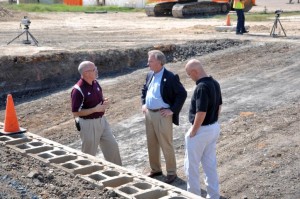
A potential new physical security barrier—historically known as a “ha-ha wall”—was first tested this week at the Texas Transportation Institute Proving Grounds in Bryan, Texas. On hand to witness the test were Texas A&M University System Chancellor John Sharp and Texas A&M System Vice Chancellor and Dean of Engineering M. Katherine Banks. The test, sponsored by the U.S. Department of State, is a part of the department’s comprehensive effort to protect the public from potential terror threats.
TTI researchers rammed a 15,000-lb medium-duty truck traveling 50 miles per hour into the wall at an 11-degree down angle. It stopped just beyond a meter of the face of the wall, which was deemed a success and worthy of further testing to perfect the design for the marketplace.
The test wall, which was designed by TTI researchers and built by an outside contractor, is the newest physical security barrier to be evaluated by the Institute. Ha-ha walls were a landscaping retaining wall feature built in the 17th and 18th centuries on English country estates, according to the BBC’s website. They typically formed a boundary between the estate’s gardens and grounds and were constructed to be invisible from the house, ensuring a clear view across the estate and providing an effective barrier to livestock.
“We thought that this long-established landscape architecture feature might provide a more attractive alternative to some of the other types of barriers currently used to keep embassies and other public buildings safe from terrorists,” said TTI Engineering Research Associate Dusty Arrington.
“We modified the historical design of the wall and optimized it for the medium-duty impact vehicle,” Arrington said. “Now we will build additional models and test them at different angles and heights to develop the most efficient ha-ha design methodology. The objective is to develop a design that will provide field engineers all of the information they need to design a ha-ha for a given threat vehicle traveling at a given speed and angle.”
“This test is part of our overall program to develop a whole range of security barriers that can be used to protect the perimeters of our embassies and other vulnerable buildings from terror attacks,” said Russell Norris, research and development program manager for the Department of State. “TTI is helping us accomplish our goal to offer a wide variety of options for security barriers to install in different situations.”
TTI, a member of The Texas A&M University System, works closely with public agencies and private-sector companies to design, construct, test and evaluate highway-safety and perimeter-security devices. TTI has performed more than 2,000 full-scale crash tests with vehicles weighing from 1,200 to 80,000 lb. The Institute has 15 patented safety devices installed throughout the world, including crash cushions, breakaway signs, guardrails and barrier systems.
For more information about the Roadside Safety and Physical Security Division, visit their website.